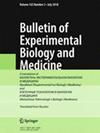Correlation between the Colony Phenotype and Amino Acid Sequence of the Variable Vaa Antigen in Clinical Isolates of Mycoplasma hominis.
IF 0.9
4区 医学
Q4 MEDICINE, RESEARCH & EXPERIMENTAL
Bulletin of Experimental Biology and Medicine
Pub Date : 2024-07-04
DOI:10.47056/0365-9615-2024-177-1-92-96
引用次数: 1
Abstract
A new Mycoplasma hominis phenotype forming mini-colonies (MC) on agar and distinct from the phenotype forming typical colonies (TC) not only in size, but also in morphology, growth rate, and resistance to adverse factors, has been previously identified. In this study, the phenotype of colonies was determined and a comparative analysis of the amino acid sequence of the main variable antigen Vaa of the laboratory strain N-34 and seven clinical isolates of M. hominis was performed. It is demonstrated that the amino acid sequence of Vaa in clinical isolates forming TC (similar to the laboratory strain N-34) is entirely analogous to that of laboratory strain. Clinical isolates forming MC carry amino acid substitutions in the variable C-terminal region of Vaa, which can contribute to adhesion to eukaryotic cells and immune evasion. The connection between colony phenotype and amino acid sequence of Vaa is established.人型支原体临床分离株的菌落表型与可变 Vaa 抗原氨基酸序列之间的相关性
以前曾发现一种新的人型支原体表型,它在琼脂上形成迷你菌落(MC),与形成典型菌落(TC)的表型不仅在大小上不同,而且在形态、生长速度和对不利因素的抵抗力上也不同。本研究确定了菌落的表型,并对实验室菌株 N-34 和 7 个临床分离的人乳头瘤病毒的主要可变抗原 Vaa 的氨基酸序列进行了比较分析。结果表明,形成 TC 的临床分离株(与实验室菌株 N-34 相似)的 Vaa 氨基酸序列与实验室菌株的完全相似。形成 MC 的临床分离株在 Vaa 的可变 C 端区域有氨基酸替代,这可能有助于粘附到真核细胞并逃避免疫。建立了菌落表型与 Vaa 氨基酸序列之间的联系。
本文章由计算机程序翻译,如有差异,请以英文原文为准。
求助全文
约1分钟内获得全文
求助全文
来源期刊

Bulletin of Experimental Biology and Medicine
医学-医学:研究与实验
CiteScore
1.50
自引率
14.30%
发文量
265
审稿时长
2 months
期刊介绍:
Bulletin of Experimental Biology and Medicine presents original peer reviewed research papers and brief reports on priority new research results in physiology, biochemistry, biophysics, pharmacology, immunology, microbiology, genetics, oncology, etc. Novel trends in science are covered in new sections of the journal - Biogerontology and Human Ecology - that first appeared in 2005.
World scientific interest in stem cells prompted inclusion into Bulletin of Experimental Biology and Medicine a quarterly scientific journal Cell Technologies in Biology and Medicine (a new Russian Academy of Medical Sciences publication since 2005). It publishes only original papers from the leading research institutions on molecular biology of stem and progenitor cells, stem cell as the basis of gene therapy, molecular language of cell-to-cell communication, cytokines, chemokines, growth and other factors, pilot projects on clinical use of stem and progenitor cells.
The Russian Volume Year is published in English from April.
 求助内容:
求助内容: 应助结果提醒方式:
应助结果提醒方式:


